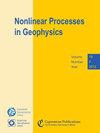两种非线性数据同化方法的比较
IF 2.4
4区 地球科学
Q3 GEOSCIENCES, MULTIDISCIPLINARY
引用次数: 0
摘要
摘要先进的数值数据同化(DA)方法,如四维变分法(4DVAR),既复杂又耗费计算成本。现有的简化方法考虑了时间可变性,有可能在降低计算成本的同时获得准确的结果。最近,针对一个非线性海洋模型提出了两种此类 DA 方法。第一种方法是 Diffusive Back and Forth Nudging (D-BFN),该方法之前已在多个复杂模型(尤其是海洋模型)中实施。第二种方法是 Larios 和 Pei 提出的凹凸非线性(CCN)方法,该方法实施简单,效果良好。D-BFN 比传统的变分法系统成本更低,但它需要在多次迭代中对模型进行前后积分,而 CCN 只需对前向模型进行一次积分。本文将研究 Larios 和 Pei 的 CCN 算法能否在简单混沌模型中提供与已测试过的 D-BFN 相媲美的结果。结果表明,观测密度和/或频率以及同化窗口的长度会对 CCN 的结果产生重大影响,而 D-BFN 对较稀疏的观测(主要是时间观测)具有相当的适应性。本文章由计算机程序翻译,如有差异,请以英文原文为准。
A Comparison of Two Nonlinear Data Assimilation Methods
Abstract. Advanced numerical data assimilation (DA) methods, such as the four-dimensional variational (4DVAR) method, are elaborate and computationally expensive. Simpler methods exist that take time-variability into account, providing the potential of accurate results with a reduced computational cost. Recently, two of these DA methods were proposed for a nonlinear ocean model. The first method is Diffusive Back and Forth Nudging (D-BFN) which has previously been implemented in several complex models, most specifically, an ocean model. The second is the Concave-Convex Nonlinearity (CCN) method provided by Larios and Pei that has a straightforward implementation and promising results. D-BFN is less costly than a traditional variational DA system but it requires integrating the model forward and backward in time over a number of iterations, whereas CCN only requires integration of the forward model once. This paper will investigate if Larios and Pei's CCN algorithm can provide competitive results with the already tested D-BFN within simple chaotic models. Results show that observation density and/or frequency, as well as the length of the assimilation window, significantly impact the results for CCN, whereas D-BFN is fairly adaptive to sparser observations, predominately in time.
求助全文
通过发布文献求助,成功后即可免费获取论文全文。
去求助
来源期刊

Nonlinear Processes in Geophysics
地学-地球化学与地球物理
CiteScore
4.00
自引率
0.00%
发文量
21
审稿时长
6-12 weeks
期刊介绍:
Nonlinear Processes in Geophysics (NPG) is an international, inter-/trans-disciplinary, non-profit journal devoted to breaking the deadlocks often faced by standard approaches in Earth and space sciences. It therefore solicits disruptive and innovative concepts and methodologies, as well as original applications of these to address the ubiquitous complexity in geoscience systems, and in interacting social and biological systems. Such systems are nonlinear, with responses strongly non-proportional to perturbations, and show an associated extreme variability across scales.
 求助内容:
求助内容: 应助结果提醒方式:
应助结果提醒方式:


